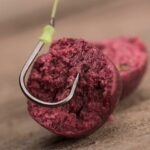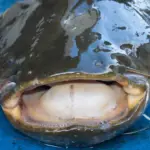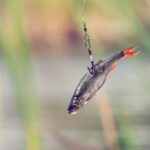Grunt fish include two families – grunters and sweetlips – and around 130 individual species. All grunters have a set of teeth in their throat that they grind together to create the distinctive sound from which they got their name.
Saltwater grunt fish prefer residence in reefs, seagrass beds, and underwater wrecks, where they can predate other small marine life.
Anglers on the hunt for a high-yield catch will find grunt fish in abundance, as they typically group up into large schools and are not particularly picky about their bait.
We’ll take a closer look at five saltwater species: black margate grunt, blue-striped grunt, brown grunt, paragrate grunt, and white grunt.
Black Margate Grunt (Anisotremus surinamensis)
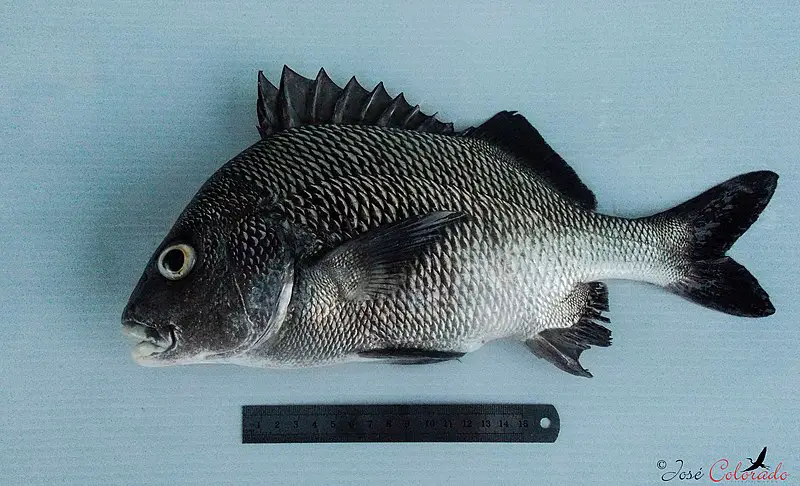
Image Source: José Francisco Colorado-Dapa, CC BY-SA 4.0 https://creativecommons.org/licenses/by-sa/4.0, via Wikimedia Commons
With its dense body, steep dorsal region, and short head, the black margate grunt more closely resembles drum fish than others of its species.
They have silver bodies that transition from darker to lighter from head to tail, as well as black fins and spines.
On average, black margate grows to around 18 inches long and weighs 8-10 pounds.
Natural Habitat
Black margate grunts patrol rocky areas and reefs across the western parts of the Atlantic floor, particularly the Gulf of Mexico and the Caribbean Sea.
These areas provide an abundance of their preferred diet of mollusks, shellfish, and sea urchins.
Catching Black Margate Grunt
The best time to find black margates is during their spawning season, from February to April, when they form large schools. You will have better luck at night when they prefer to feed.
You can attract the shoals to your boat by chumming the water with conch or mussels, then dropping your line with a similar bait. Be prepared to pull in a huge catch.
Blue-striped Grunt (Haemulon sciurus)

Image Source: Brian Gratwicke, CC BY 2.0 https://creativecommons.org/licenses/by/2.0, via Wikimedia Commons
Blue-striped grunts, which can reach a length of 12-14 inches, are one of the most colorful amongst the species.
Their almond-shaped body is yellow, with brilliant blue stripes running from their mouth to their tail. The dorsal and anal fins are dark grey or black, while the pelvic, pectoral, and anal fins are dark yellow.
Adult blue-striped grunt typically weighs less than 1.5 pounds.
Natural Habitat
This grunt patrols reefs and seagrasses of the Atlantic Ocean from South Carolina to Brazil, where they feast on other small fish.
Catching Bluestriped Grunt
As nocturnal feeders, you’ll find the largest groups of blue-striped grunt near shallow reefs no deeper than 100 feet.
They are opportunistic hunters that startle easily, so you can take your pick of small baitfish and keep the boat still.
Brown Grunt (Haemulon aurolineatum)

Image Source: Williams, J. T.; Carpenter, K. E.; Van Tassell, J. L.; Hoetjes, P.; Toller, W.; Etnoyer, P.; Smith, M., CC BY 2.5 https://creativecommons.org/licenses/by/2.5, via Wikimedia Commons
Brown grunts are more widely known as the tomtate and have long, silvery almond-shaped bodies with brassy stripes running along the side. Their fins and spines are a cloudy yellow color.
Tomtate rarely grows longer than 10 inches or weighs more than 1.5 pounds.
Natural Habitat
Like many of its brethren, brown grunt prefers the Atlantic waters but is more tolerant of the colder areas near Massachusetts. You can find them as far south as the Gulf of Mexico in the nearshore reefs and grassy seabeds.
Catching Brown Grunt
Tomtates are a pretty uncommon catch. If you snag one, save them as baitfish for larger species like grouper and snapper.
You can find them near shore, clustered around piers, docks, or rocks. They prefer invertebrates and shellfish, so worms or crab pieces are excellent bait.
Paragrate Grunt (Anisotremus virginicus)
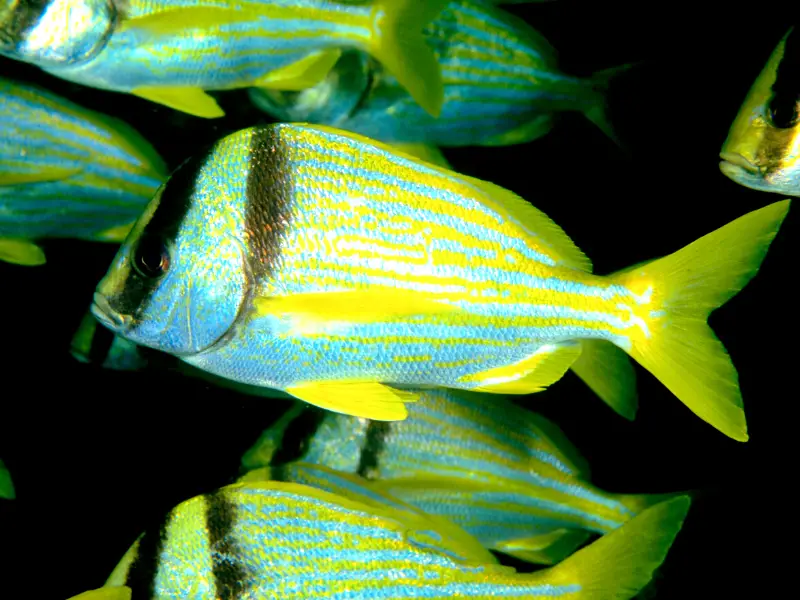
The paragrate grunt sometimes goes by the name porkfish or dogfish and boasts an eye-catching appearance that includes a pale, silver body, two thick black stripes on its head, and neon yellow horizontal stripes, dorsal, and fins.
Porkfish can be up to 16 inches long but typically reach lengths closer to 10 inches and weigh a little over 2 pounds.
Natural Habitat
Paragrate grunt occupies the shallow Atlantic shoreline south of Florida to Brazil. They group into large schools on reefs, eating invertebrates, shellfish, and parasites from the scales of other fish.
Catching Paragrate Grunt
Bait your hook with smaller pieces of crab, worms, or mussels, and stick close to the coast.
You’re most likely to find shoals of paragrate grunt swimming along the sandy bottom, though they sometimes group up with white grunt roaming the reef.
White Grunt (Haemulon plumieri)
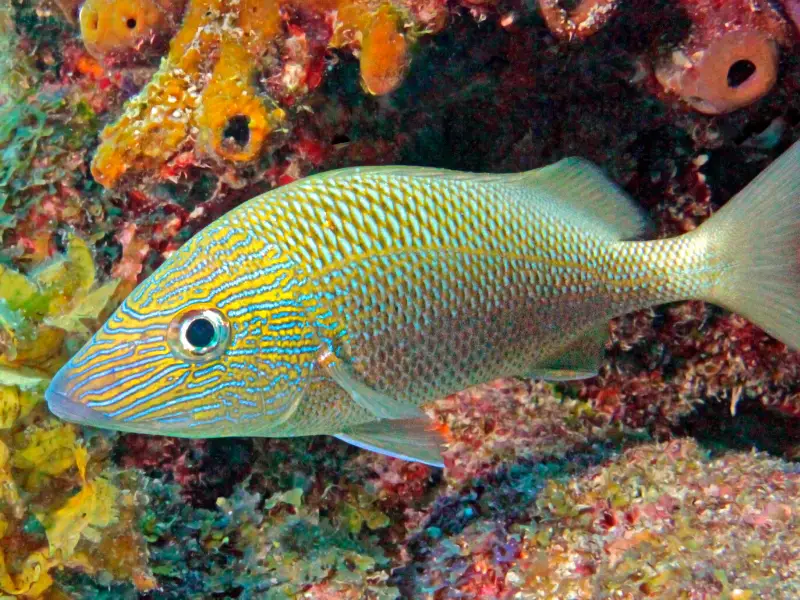
White grunts are sometimes known as the common, Key West, or Florida grunt fish. It has a distinctive, bright red inner mouth lining contrasting sharply against its dusky head coloring and smoky body scales.
Its head, which is much more narrow than its body, has alternating blue and yellow stripes, while the fins and spiky dorsal range from pale yellow to greyish-brown.
This fish has an average length of 17 inches and a weight of 5.5 pounds.
Natural Habitat
As its name would suggest, white grunts are most abundant in the warmest Atlantic waters off the coast of Florida and as far south as Brazil.
They cluster along sandy shorelines and shallow reefs, rarely going deeper than 80 feet, and feed on other small fish, mollusks, and crustaceans.
Juveniles prefer coastal seagrass beds, forming large schools according to their size.
Catching White Grunt
The Florida grunt is probably the most popular of the family for eating, as they offer massive catch potential and require little work to make a meal if you can track down a school.
They’re ideal for new anglers who need a little practice before moving on to more challenging catches.
They are most likely to bite if you arm your hook with shrimp or smaller pieces of other baitfish and use the bottom bouncing technique to lure them out of rocky coves.
Anglers can also take them with bottom trawls or fish traps.
Final Thoughts
While grunt isn’t the most popular eating fish, they present plenty of opportunities to haul in catch after catch without venturing too far from the shoreline.
If you track down a spawning school, you’ll be treated to an abundance of delicious panfish with white, flaky meat or the perfect bait to haul in larger prey.
It’s no trophy catch, but grunts are a satisfying fish for those days when you’re looking for quantity over quality.
- Do You Need An Indicator For Nymph Fishing? - November 16, 2023
- Fishing Safety Tips For Families - September 25, 2023
- What Is The Best Time To Night Fish At A Lake? - September 18, 2023

